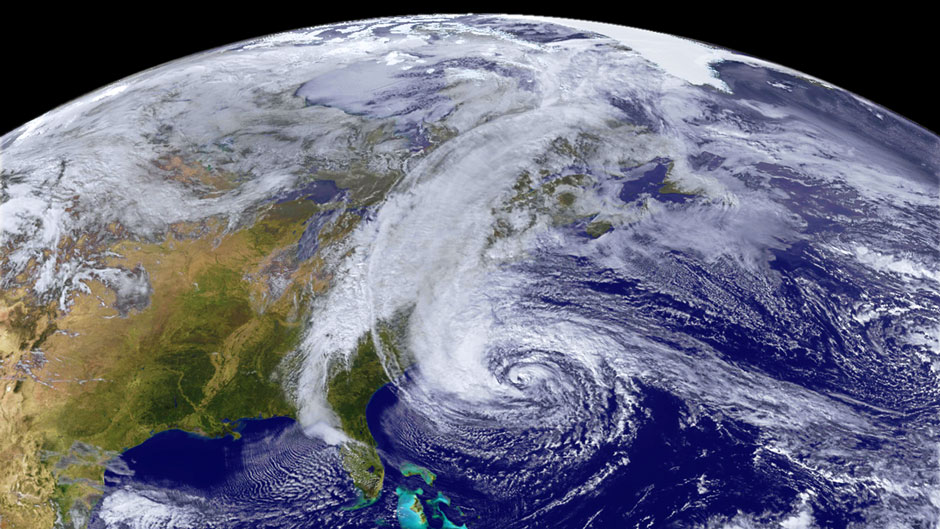On the Saffir-Simpson wind scale, Hurricane Sandy didn’t appear to be the monster that some storms are, registering as only a Category 1 cyclone when it hit the New York and New Jersey coastlines in late October 2012.
But it was Sandy’s size—measuring more than 900 miles at its greatest expanse—and the tremendous storm surge it generated that made it a true superstorm.
The numeric category assigned to a hurricane provides only a partial picture, never revealing characteristics such as impacts, the speed at which it is moving, or its barometric pressure, said Tyreek Frazier, an undergraduate meteorology student at the University of Miami Rosenstiel School of Marine and Atmospheric Science.
Frazier delivered his comments last Friday as part of “Preparing for the 2021 Atlantic Hurricane Season.” Presented by the education and outreach student group ’Canes on ’Canes, the hour-long webinar provided an outlook of this year’s tropical cyclone season, tips on how to prepare for it and where to find reliable forecast information, and an overview of hurricane research underway at the Rosenstiel School.
Hurricane Sandy—which killed 44 New York residents, caused an estimated $19 billion in damages in the city, and displaced thousands of people—is an example of why all attributes of a hurricane must be analyzed, Frazier explained. By the time Sandy hit the area, for example, it had become a hybrid of two storm systems, prompting meteorologists and the press to call it a “Frankenstorm.”
Forecasters at the National Oceanic and Atmospheric Administration are predicting 2021 to be an above-average hurricane season, with the lack of El Niño conditions to counteract the warmer-than-average subtropical Atlantic Ocean temperatures factoring into their outlook.
But it is important to remember that seasonal outlooks do not forecast how many storms will make landfall, cautioned Quinton Lawton, a Ph.D. candidate in atmospheric sciences. “You can have a below-average season and still get tons of U.S. landfalls,” he said. “Or you can have an above-average season and not get many landfalls.”
What is always certain, though, is that “hurricanes are complex in nature,” Frazier said.
Rosenstiel School scientists are helping to demystify tropical cyclones, conducting research that delves into a multitude of areas. And during last week’s webinar, Kurt Hansen, a Ph.D. candidate in atmospheric sciences, provided a brief glimpse of some of the research projects at the Virginia Key-based school, including his own work with atmospheric scientist Ben Kirtman to predict hurricanes weeks in advance in the subseasonal range. Fifth-year doctoral student James Hlywiak is studying how surface conditions near land affect the near-surface winds within a hurricane. And Sharan Majumdar, a professor of atmospheric sciences,is exploring alternative ways to communicate hurricane risk.
What you will not find, however, is research on stopping, delaying, or decreasing the intensity of hurricanes. “Overall, [hurricanes] are just too incredibly powerful,” said Hansen, noting that even an average tropical cyclone produces wind energy equivalent to about half the worldwide electric-generating capacity.
It’s not as if such research has never been tried, he noted. From 1962 to 1983, the federal government flew aircraft into storms and seeded them with silver iodide, hoping to supercool the cyclones and disrupt their inner structure. But the project had little success. “What they found out is that hurricanes go through eyewall replacement cycles. So even if you destroy the inner eyewall, another one forms around it and replaces it,” Hansen explained.
Just as vital as the Rosenstiel School’s ongoing research is knowing where to locate reliable sources for up-to-date information on storms before, during, and after they strike. But with so many different social media outlets claiming to offer extensive pre- and post-storm information, that can sometimes be difficult to do, said Marybeth Arcodia, a Ph.D. candidate in atmospheric sciences. The Rosenstiel School, she noted, has compiled a comprehensive list of websites featuring reliable storm details.
Touri White, who is earning his master’s degree in coastal zone management with an emphasis on broadcast meteorology and is conducting research on how hurricanes impact coastlines, gave a presentation on storm readiness, offering advice on preparing a disaster kit, making evacuation plans, and preparing a home when a hurricane is imminent. He noted that while we are expecting a more active season than normal, even a slow season can be disastrous.
“Remember that it only takes one,” he said.
Watch a recording of the webinar here.

